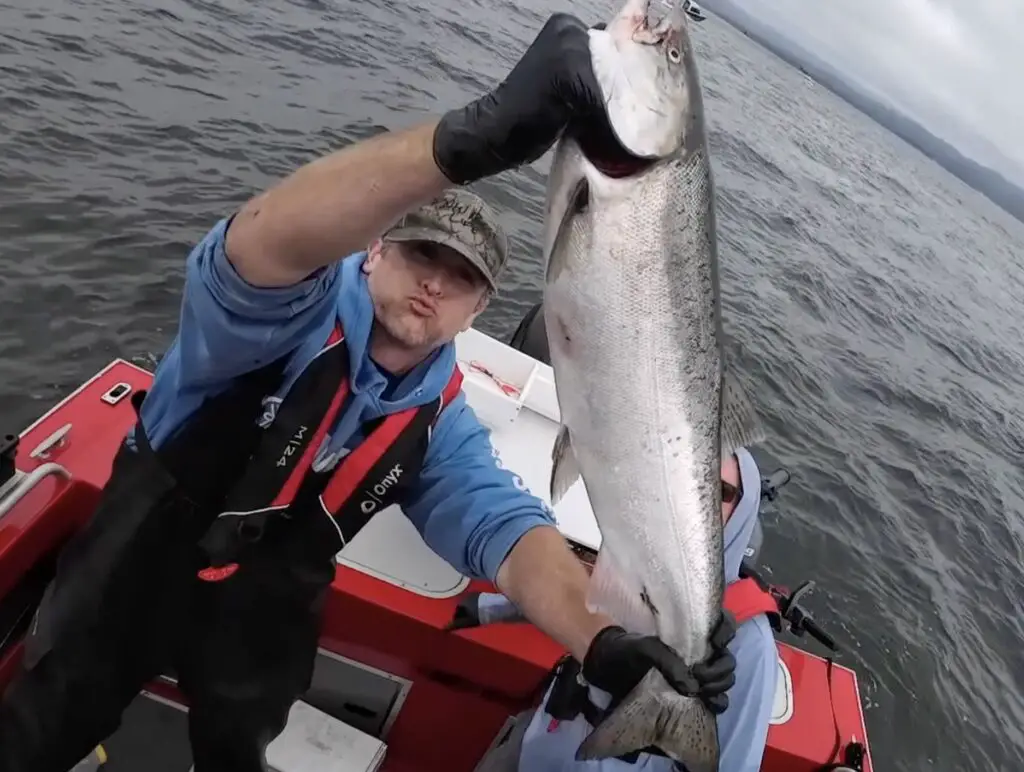
Every year I have a friend who has fished with me from Arizona for the past 14 years. We’ve done many fisheries all over Western Washington and this year we decided to take on the mother of them all: Buoy 10.
Keep reading to learn why we chose Buoy 10, why you should consider it, and a few lessons we learned as Buoy 10 newbs.
We typically make trips to places like Port Angeles, Sekiu, and Neah Bay, staying 4-5 days and really taking it all in, fishing for multiple species and coming back with loads of fish. We even trailer’d my previous boat all the way to Port Hardy on Vancouver Island and had an absolute blast.
Nowhere will you find a greater confluence of catchable fresh salmon and people chasing them, than what you find at Buoy 10.
Why Buoy 10?
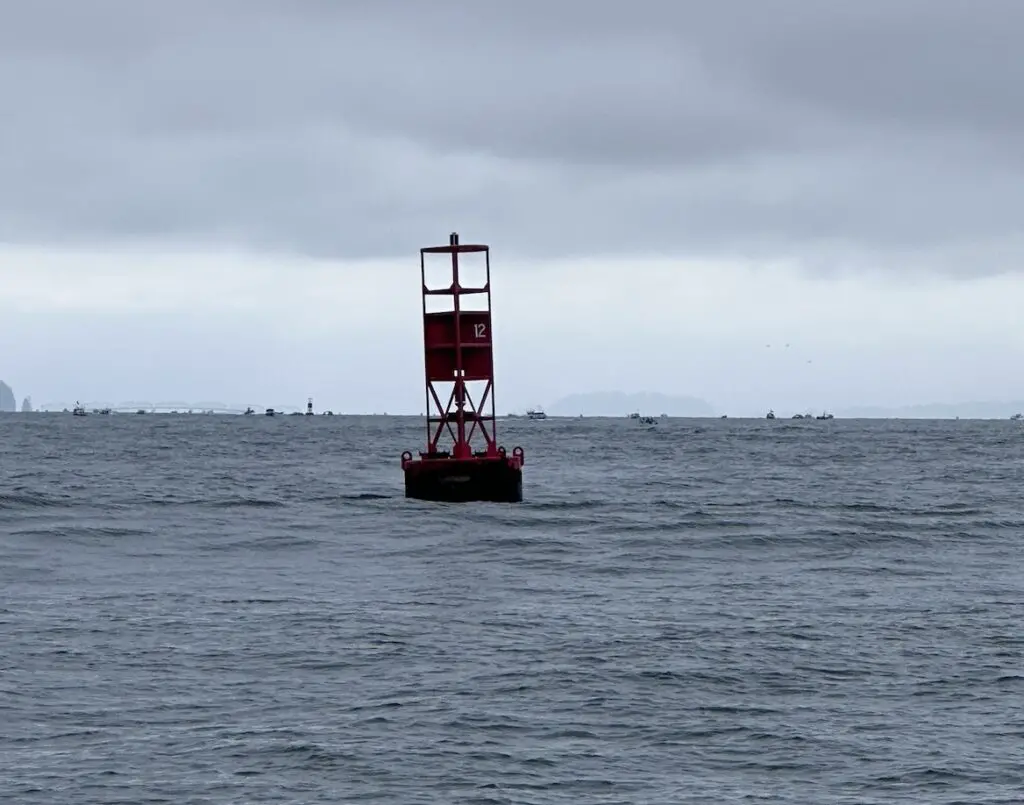
I could get pretty technical on this answer, but I will simplify it down to say that the management of the seasons of Columbia River salmon is structurally more predictable than Puget Sound and the Strait.
The above statement is true for a multitude of reasons, not least of them being the ESA listing status of Chinook in Puget Sound. I mean…if you’re a Puget Sound salmon angler like many of the followers of this blog, you know exactly what I’m talking about. But in case you need a painful reminder:
Marine Area 11 got 14 days of total fishing for chinook over a 3 month period in 2023
Marine Area 10 shutdown for chinook retention just as the bulk of migrating chinook showed up in 2023, but “magically” opened for several days afterward based on test fishing numbers revised by 50% (?!?).
Marine Area 7 has around 3-5 total days of chinook fishing compared to 9 months in years past.
Marine Area 5 in 2022 shut down every other day for chinook fishing in July and Marine Area 4 closed to chinook fishing entirely for most of July 2022.
Yes, I get it, Buoy 10 will sometimes shut down early, and yes Marine Area 2 eliminated Chinook retention for a time on Friday and Saturday, but I’m sorry, you cannot compare the two fisheries management situations. They are not even remotely the same.
If you’re looking to plan a trip with folks from out of town and you need to know there’s going to be a fishery in the future you are in a much better situation considering Buoy 10 than anywhere along the migratory path of Puget Sound chinook.
Maybe Canada should be back on the menu as well, yes?
Buoy 10 is intimidating, how do I get started?
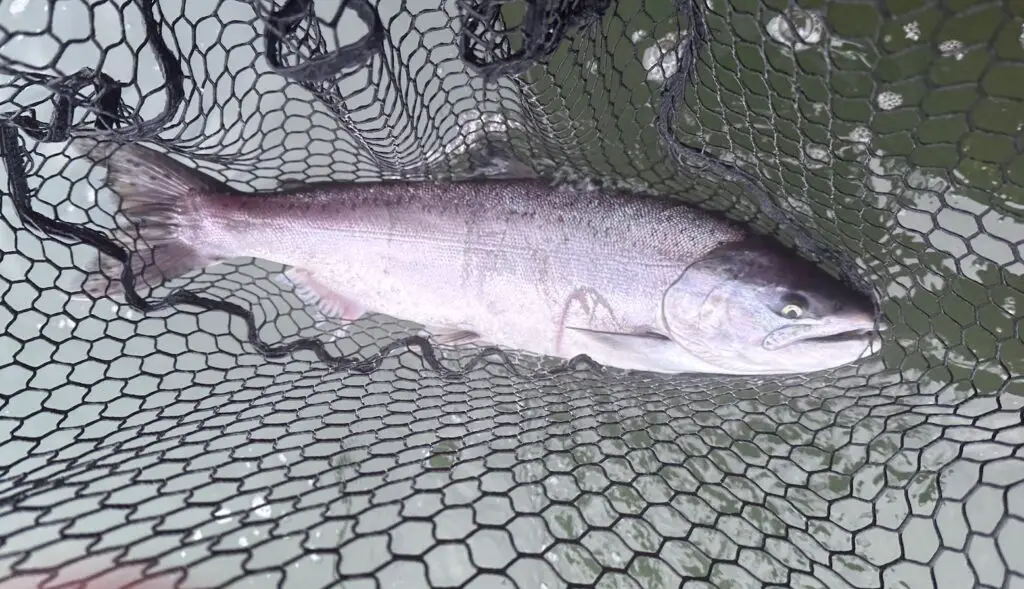
There are many resources out there, but when it comes to something like this, I like to start with a good old-fashioned book on the subject.
Standard disclaimer: PNWBestLife.com is an Amazon affiliate, we make a small commission off of products purchased using our links, and that goes to support the blog. You pay the same price regardless of whether you use our links or not. Thanks for your support!
The above is what I read to get prepped and while there are plenty of references to things better searched on Google or other internet sources that are more recently updated, the main topics of the book to get you primed for fishing Buoy 10 are outstanding.
My biggest mistake honestly, was not reading through a few critical sections after my first day on the water. You need to get time on the water and then come back to some of the material to really let it sink in.
Another option I will definitely consider is hiring a guide for the first day of the trip. To really learn how the pros do it. This is one fishery where the guides really out-fish the majority of the fleet, so it might be worth it to consider.
On that note, if you are a Buoy 10 guide and want to collaborate with me on Buoy 10 recommendations, reach out and let’s chat. kyle@pnwbestlife.com on email or @pacificnwbestlife on Instagram. Also pnwbestlife page on Facebook.
The bottom line is, don’t be intimidated, plan a trip and begin the learning journey. There’s actually quite a bit that translates from fishing the Puget Sound in places like Marine Area 11, 10, and 13 to fishing Buoy 10 and I will explain why a bit later here.
But let’s start with the biggest difference and learning curve factor.
Buoy 10 is all about the tides.
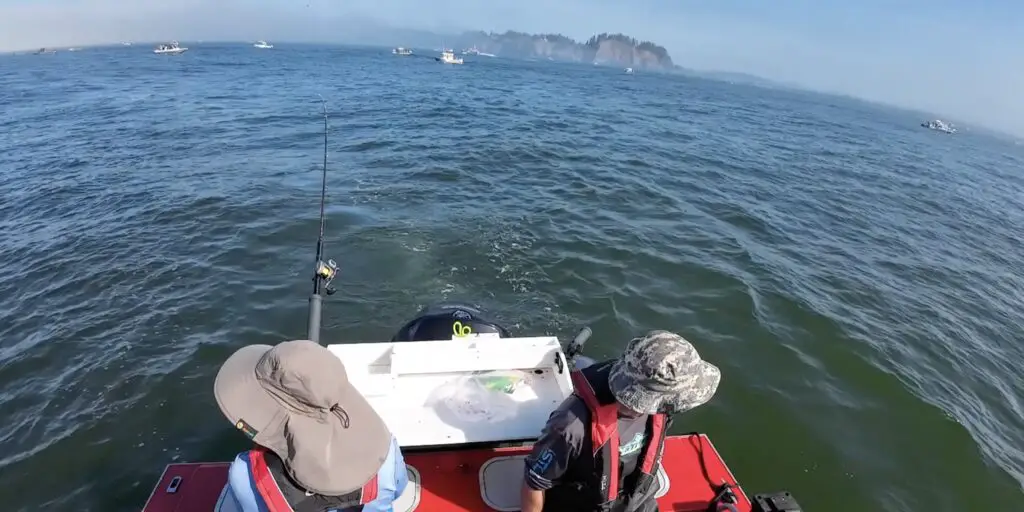
Wait, isn’t Puget Sound also all about the tides? Well, yeah, but not to the degree that Buoy 10 is, and I will explain why.
Just like in Puget Sound, the tides help you find the fish, but in Buoy 10, it also dictates how you fish.
Additionally, you can fish multiple places around Puget Sound on specific tides, or often times the same area fishes well on both tides, but with Buoy 10 it’s even more specific where you fish because you are following fish up on the current tide, or hoping to intercept fish from the previous tide.
The bite as it were at Buoy 10 happens extremely fast, and if you aren’t in the right place at the right time, fishing the right way, you will miss it. So there’s a premium on learning how to follow the push of fish based on reading the tide table.
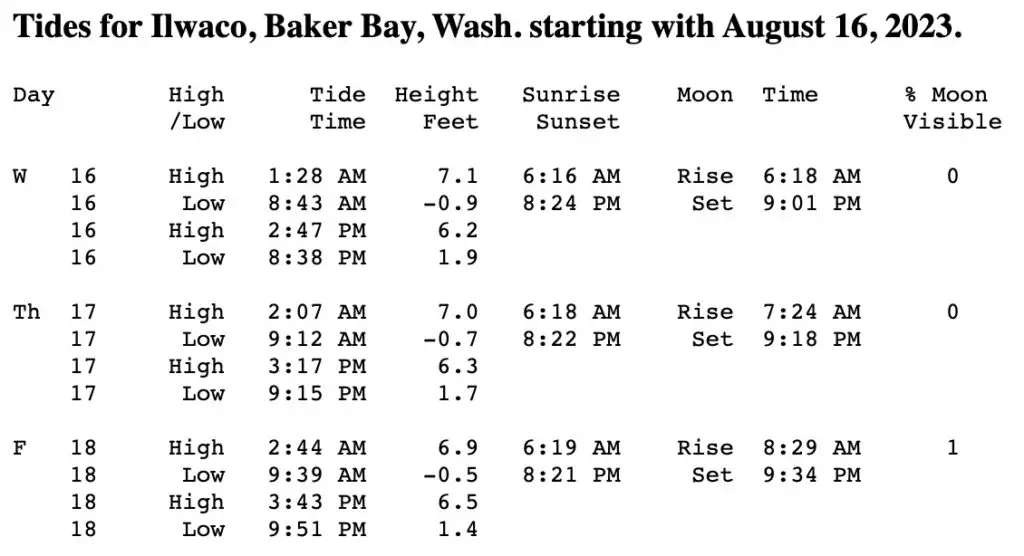
Here’s an example from our trip:
The above tides in the morning or early afternoon are what we fished on our 3-day trip. These are not great tides for Buoy 10, and while we struggled, most everyone we talked to or heard about also struggled, even some guides, though many guides still got their clients on fish these days.
We had 6 legit takedowns on Wednesday the 16th. We got the first 3 holding in the current, with our bow pointed towards the ocean, right around Buoy 12 with the flood / incoming tide pushing us slowly upriver as we back-trolled into it.
We got bit on our anchovy in helmet setup 2x and on a big toman spinner once during that time period from about 11:30 am to 12 pm, fishing with our gear no more than 20 ft down as fish are suspended following the dense saltwater push upriver.
We ran upriver to below the bridge after that bite cooled off, held in the current up there, and got bit once more on the anchovy and twice more on two different Toman spinners.
What about our time on the water from sunrise to 11:30 am? We kind of messed that up, we were hanging out too close to Ilwaco waiting for the turn near Buoy 10 when we probably should have been off of Desdemona Sands working our way down fishing very close to the bottom with the last bit of ebb, we did that on the subsequent days and either caught fish or were around others catching fish.
What I’m trying to explain is that your depth of gear and where you fish change quite a bit based on exactly what part of the tide you are fishing.
We were fishing too low in the flood current at first and it took us a while to get bit until we brought our gear up. We realized that the correct depth to fish was being shown by our fish finder that thought the dense ocean water flooding in below was the river bottom, giving us an easy clue as to how far down to fish. The idea is you want to be a few feet above that ocean water.
So what can I take from Puget Sound and apply to Buoy 10?
Buoy 10 Chinook act a lot like Chinook from Puget Sound just before they head upriver. They are in a very similar metabolic state. They aren’t feeding as often, and things like low light conditions, tide changes, etc all can trigger bites.
Additionally, scent becomes very important to the Puget Sound fisherman in places like the South Sound, because we are trying to trigger a bite on salmon that may not be as interested in feeding.
I made a how-to video about chinook fishing for actively feeding chinook, and you can throw much of that out the window in both the South Sound and in Buoy 10. When chinook are actively feeding, you can drop an unscented spoon in front of them and they whack it.
In Marine Area 2, we were limiting on chinook in a very short period of time just on spoons.
The one new addition to the Puget Sound fisherman’s tackle box is the big inline spinners that these buoy 10 chinook seem to like, and also the use of triangle flashers, though 360 flashers are still a big part of the approach.
But fishing with bait like cut plug herring, or anchovies in a helmet get bit. Fishing with spinfish or super bait filled with tuna that’s sauced up gets bit. And trolling on the slower side to give fish a bit of a longer look (and sniff!) to provoke a bite via the use of the protroll flashers with the agitator fin that causes it to rotate at lower speeds, all factor in here.
Wrapping up my intro to Buoy 10 fishing…
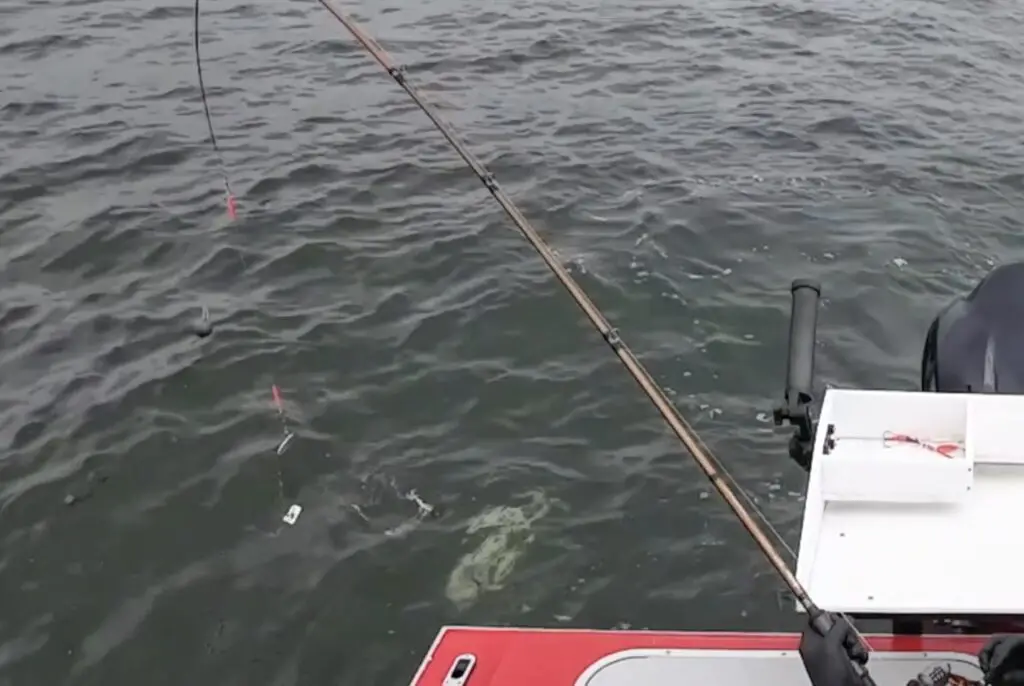
I plan to write much more about this in the future, as I fish it more and learn more, I will definitely share more, but hopefully, you get an idea of how to approach things. In reality, there’s much more that could and should be said about things like weather and safety, working around hordes of other boats, river currents, etc.
I just wanted to give you a flavor of things and give you something to think about for 2024 fishing trip planning.